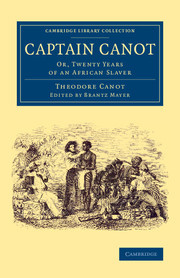Description
Captain Canot
Or, Twenty Years of an African Slaver
Cambridge Library Collection - Slavery and Abolition Series
Author: Canot Theodore
Coordinator: Mayer Brantz
Published in 1854, a first-hand account of the life of a slaver, giving an intimate insight into the slave trade.
Language: English
Subject for Captain Canot:
Approximative price 44.52 €
In Print (Delivery period: 14 days).
Add to cart
Publication date: 07-2015
Support: Print on demand
Support: Print on demand
Description
/li>Contents
/li>
The career of the Franco-Italian slave trader Theodore Canot (1804?60) was long and eventful. This intimate and sometimes graphic insight into the slave trade, first published in 1854, was edited by the American historian and author Brantz Mayer (1809?79), who compiled it in close collaboration with Canot. Brantz considered his subject to be a man of unquestionable integrity whose story needed to be heard. Beginning with Canot's introduction to seafaring, the book is enriched by vivid anecdotes and occasional illustrations. From an encounter with Lord Byron to shocking descriptions of massacres, the narrative describes multiple aspects of the slave trade: purchasing slaves; storing human cargo; the suppression of slave revolts; the establishment of the slave trade in new regions; and the legal, financial and practical requirements of running a slave ship. A counterpoint to accounts by slaves themselves, this work reflects the attitudes of its time.
1. My parentage and education; 2. My uncle tells my adventure; 3. I design going to South America; 4. Bury my body in the sand to escape the insects; 5. Life on a sand key; 6. I am sent from the key; 7. Reflections on my conduct and character; 8. I take possession of my new quarters; 9. Pains and dreariness of the 'wet season'; 10. Mode of purchasing slaves at factories; 11. An epoch in my life in 1827; 12. How a cargo of slaves is landed in Cuba; 13. I become intimate with 'country princes' and receive their presents; 14. Joseph, my partner, has to fly from Africa; 15. I study the institution of slavery in Africa; 16. Caravan announced; 17. I set forth on my journey to Timbo; 18. A ride on horseback; 19. A night bivouac in the forest; 20. Spread of Mahometanism in the interior of Africa; 21. We approach Tamisso; 22. Improved character of the country and population as we advance to the interior; 23. Our caravan proceeds towards Timbo; 24. Site of Timbo and the surrounding country; 25. My home journey; 26. Arrival of a French slaver; 27. Ormond communicates with the Spaniard; 28. Capt. Escudero of the Esperanza dies; 29. Off to sea; 30. I am sent on board the corvette; 31. I drift away in a boat with my servant; 32. My greeting in Kambia; 33. A visit to the Matacan river in quest of slaves; 34. What became of the Esperanza's officers and crew; 35. I escape capture; 36. A 'white squall'; 37. A long holiday; 38. Our captain longs for calomel, and how I get it from a Scotchman; 39. My returns from the voyage $12,000, and how I apply them; 40. All Africans believe in divinities, except the Bagers; 41. My voyage home in the Estrella; 42. Smallpox and a necessary murder; 43. The Aguila de Oro, a Chesapeake clipper; 44. I am sent to France in the frigate Flora; 45. Madame Sorret and my new quarters; 46. New lodgers in our quarters; 47. Monsieur Germaine, the forger; 48. Plan of escape; 49. Condition of the sentinel when he was found; 50. I go to Portugal; 51. I reach Goree, and hasten to Sierra Leone; 52. Anecdotes of Blanco; 53. I visit Liberia; 54. My establishment at New Sestros, and how I created the slave trade in that region; 55. No river at New Sestros ; 56. I go on a pleasure voyage in the Brilliant; 57. What Don Pedro Blanco thought of my Quixotism; 58. My compliments to British cruisers; 59. Ups and downs; 60. The confession of a dying sailor; 61. My establishment at Digby; 62. I escape from the bloody scene in a boat; 63. Don Pedro Blanco leaves Gallinas; 64. I make arrangements for future trade and business with Mr. Redman; 65. I find my establishment in danger; 66. I am attacked by the British cruiser Termagant; 67. My barracooons destroyed; 68. We land at Cape Mount; 69. Visit to Monrovia; 70. I remove, and settle permanently at New Florence; 71. Account of the character of the Vey negroes; 72. My workshops, gardens and plantations; 73. Fana-Toro's war, and its effect on my establishment.
© 2024 LAVOISIER S.A.S.




